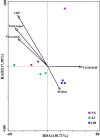Diversity and spatiotemporal dynamics of fungal communities in the rhizosphere soil of Lycium barbarum L.: a new insight into the mechanism of geoherb formation
- PMID: 35217917
- PMCID: PMC8881256
- DOI: 10.1007/s00203-022-02781-5
Diversity and spatiotemporal dynamics of fungal communities in the rhizosphere soil of Lycium barbarum L.: a new insight into the mechanism of geoherb formation
Abstract
Lycium barbarum L. is a well-known traditional geoherb in Ningxia, China. The fruits of L. barbarum contain several dietary constituents, and thus, they exert many beneficial effects on human health. However, a few studies have been conducted on the geoherb L. barbarum and its rhizosphere soil fungal community. In this study, we determined the physicochemical properties and fungal community structure of rhizosphere soil of L. barbarum from three regions of China, namely Ningxia (NX), Qinghai (QH), and Xinjiang (XJ), during three development stages of L. barbarum. Soil pH varied between 7.56 and 8.60 across the three regions, indicating that alkaline soil is conducive to the growth of L. barbarum. The majority of soil properties in NX, an authentic geoherb-producing area, were substantially inferior to those in XJ and QH during all three developmental stages. Total sugar, polysaccharide (LBP), and flavonoid contents were the highest in wolfberry fruits from NX. High-throughput sequencing showed that the abundance of the soil fungal population in NX was higher than that in QH and XJ during the flowering and fruiting stage and summer dormant stage. Moreover, the soil fungal diversity increased with the development of wolfberry. Ascomycota and Mortierellomycota were the predominant phyla in the rhizosphere fungal communities in all samples. Redundancy analysis showed a significant correlation of the soil-available phosphorus and LBP of wolfberry fruits with the fungal community composition. The characteristics of rhizosphere fungal communities determined in the present study provide insights into the mechanism of geoherb formation in NX wolfberry.
Keywords: Fungal community diversity; Geoherbs; Lycium barbarum L.; Rhizosphere soil.
© 2022. The Author(s).
Conflict of interest statement
The authors declare that they have no conflict of interest.
Figures



Similar articles
-
Response of soil chemical properties and microbial community characteristics in Lycium barbarum orchard to planting years.Ying Yong Sheng Tai Xue Bao. 2024 Dec 18;35(12):3453-3460. doi: 10.13287/j.1001-9332.202412.018. Ying Yong Sheng Tai Xue Bao. 2024. PMID: 40383897 English.
-
[Effects of Continuous Cropping on the Physiochemical Properties, Pesticide Residues, and Microbial Community in the Root Zone Soil of Lycium barbarum].Huan Jing Ke Xue. 2024 Sep 8;45(9):5578-5590. doi: 10.13227/j.hjkx.202311078. Huan Jing Ke Xue. 2024. PMID: 39323174 Chinese.
-
Elucidating the interaction of rhizosphere bacteria and environmental factors in influencing active ingredient content of Lycium barbarum fruit in China.J Appl Microbiol. 2022 May;132(5):3783-3796. doi: 10.1111/jam.15502. Epub 2022 Mar 8. J Appl Microbiol. 2022. PMID: 35191572
-
Mechanism of glycometabolism regulation by bioactive compounds from the fruits of Lycium barbarum: A review.Food Res Int. 2022 Sep;159:111408. doi: 10.1016/j.foodres.2022.111408. Epub 2022 May 26. Food Res Int. 2022. PMID: 35940747 Review.
-
Bioactive Components of Lycium barbarum and Deep-Processing Fermentation Products.Molecules. 2023 Dec 12;28(24):8044. doi: 10.3390/molecules28248044. Molecules. 2023. PMID: 38138534 Free PMC article. Review.
Cited by
-
Differentially enriched fungal communities in root rot resistant and susceptible varieties of tobacco (Nicotiana tabacum L.) under continuous monoculture cropping.Front Microbiol. 2022 Dec 7;13:1036091. doi: 10.3389/fmicb.2022.1036091. eCollection 2022. Front Microbiol. 2022. PMID: 36569055 Free PMC article.
-
Biochar-based organic fertilizer application promotes the alleviation of tobacco (Nicotiana tabacum L.) continuous cropping obstacles by improving soil chemical properties and microbial community structure.BMC Plant Biol. 2025 Mar 1;25(1):271. doi: 10.1186/s12870-025-06266-7. BMC Plant Biol. 2025. PMID: 40021953 Free PMC article.
-
Effects of nitrogen input on soil bacterial community structure and soil nitrogen cycling in the rhizosphere soil of Lycium barbarum L.Front Microbiol. 2023 Jan 10;13:1070817. doi: 10.3389/fmicb.2022.1070817. eCollection 2022. Front Microbiol. 2023. PMID: 36704567 Free PMC article.
-
Shift in the rhizosphere soil fungal community associated with root rot infection of Plukenetia volubilis Linneo caused by Fusarium and Rhizopus species.Int Microbiol. 2024 Aug;27(4):1231-1247. doi: 10.1007/s10123-023-00470-x. Epub 2023 Dec 29. Int Microbiol. 2024. PMID: 38158469
-
Research on the Influence of DNN-Based Cross-Media Data Analysis on College Students' New Media Literacy.Comput Intell Neurosci. 2022 Aug 3;2022:9224834. doi: 10.1155/2022/9224834. eCollection 2022. Comput Intell Neurosci. 2022. Retraction in: Comput Intell Neurosci. 2023 Oct 4;2023:9796361. doi: 10.1155/2023/9796361. PMID: 35965761 Free PMC article. Retracted.
References
-
- Acosta-Martínez V. Predominant bacterial and fungal assemblages in agricultural soils during a record drought/heat wave and linkages to enzyme activities of biogeochemical cycling. Appl Soil Ecol. 2014;84:69–82. doi: 10.1016/j.apsoil.2014.06.005. - DOI
-
- Amagase H, Farnsworth NR. A review of botanical characteristics, phytochemistry, clinical relevance in efficacy and safety of Lycium barbarum fruit (Goji) Food Res Int. 2011;44:1702–1717. doi: 10.1016/j.foodres.2011.03.027. - DOI
MeSH terms
Substances
Grants and funding
LinkOut - more resources
Full Text Sources
Miscellaneous

